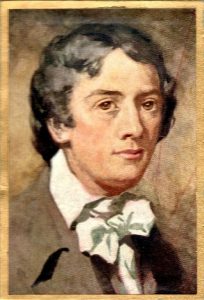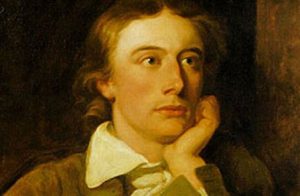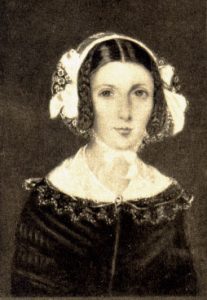
John Keats, an English romantic poet, had a short life filled with tragedy from a young age. His experience and emotions are seen in his poetry. He was dedicated to poetry and he devoted his short life to the perfection of poetry. His poems were marked with intense and rich imagery as well as melodic beauty.

Early life
Keats was born on October 31, 1795 in London. Keats’s father had crossed the social barrier and married his mother and he was known for his charm, energy and respectability. Keats’s parents were affectionate and loving towards their children. He lost his father in 1804 and mother in 1810.
In 1811, Keats joined as an apprentice to a druggist in Edmonton, England. Keats devotion to arts and poetry could not seize even while he was studying medicine. Keats produced his first write-up – short poem entitled “Imitation of Spenser”, inspired by Edmund Spenser’s “Faerie Queene”. Keats was introduced to a group of English poets by a publisher, Hunt, which included Percy Bysshe Shelley and William Wordsworth.
The Poet Keats 
Keats first volume of poetry was published in 1817 as “Poems by John Keats”. The same year he published “Endymion”. However, Keats’ daring and bold style brought criticism from two of England’s most well-regarded publications, Blackwood’s Magazine and Quarterly Review. Some of the readers did not like the lengthy poem and even found the general flow hard to follow as well as confusing.
Even though Keats’ poems were not received well by the critics, he kept on writing. By the end of 1817, he started re-examining the role of poetry in society. He visioned a kind of poetry that illustrated its beauty from the real world and human experiences. However, in summer 1818, Keats returned home to take care of his brother, Tom, who was suffering from tuberculosis. By this time, he had fallen in love with Fanny. He continued to write.
In fact, his reputation grew after death and by the end of the nineteenth century, he became one of the most loved English poets. The poetry of Keats is recognized by sensual imagery. The first Shakespearean Sonnet was published in January 1818, “When I have fears that I may cease to be”. Two months later, Keats published “Isabella”, a poem that describes a woman who falls in love with a man below her social level.
In the later half of 1819, Keats wrote his only drama, “Otho the Great”. A sensuous work “The Autumn” was published in 1820 and with this Keats crafted a style of his own which was filled with more sensualities than other contemporary poets. The last long poem Keats wrote was “Lamia”.
 Later in life
Later in life
His health started declining and in September 1820, Keats left for Italy on an invitation from P B Shelley, a poet and his friend. He had promised Fanny to marry her after he returned and they had planned to live together. However, he died in Rome on February 23, 1821. He was just twenty-five years of age at that time.
Keats’s poems are filled with an inexplicable yet uplifting sense of beauty and happiness. His works explore immense possibilities but do not cover enduring problems of life. Keats wanted to experience life and not go after its perfect understanding.
Letters written by John Keats
There are about two hundred and forty of Keats’s letters survive. Here is a list of Keats’ letters with the text of each of the letters (upcoming). There is brief summary and background of each of the letters. Reproduction of letters is the word for word.
John Keats’ Letters sent to Benjamin Bailey (1791-1853)
Letter on 8 October 1817
Letter on 13 March 1818
Letter on 21, 25 May 1818
Letter on 10 June 1818
Letters sent by John Keats to Frances (Fanny) Brawne (1800-1865)
Fanny Brawne, 11 October 1819
Fanny Brawne, 13 October 1819
Fanny Brawne, 19 October 1819
Fanny Brawne, February 1820 collection
Fanny Brawne, March 1820 collection
Fanny Brawne, May 1820 collection
John Keats’ letters to Charles Brown (1787-1842)
To Charles Brown, 30 September 1820
To Charles Brown, 1 November 1820
To Charles Brown, 30 November 1820
John Keats’ letter to Charles Cowden Clarke (1787-1877)
Letter to Charles Wentworth Dilke (1789-1864)
Letter to William Haslam (1795/1798(?)-1851)
Benjamin Robert Haydon (1786-1846)
To Benjamin Robert Haydon, 10-11 May 1817
To Benjamin Robert Haydon, 23 January 1818
This page also includes a note to John Taylor.
To Benjamin Robert Haydon, 8 April 1818
James Henry Leigh Hunt (1784-1859)
To Leigh Hunt, 10 May 1817
Frances Mary (Fanny) Keats (1803-1889)
To Fanny Keats, 26 (?) October 1819
To Fanny Keats, 8 February 1820
To Fanny Keats, 14 February 1820
To Fanny Keats, 20 March 1820
To Fanny Keats, 11 September 1820
George Keats (1797-1841)
George Keats and Georgiana Augusta Wylie Keats (1798-1879)
To George and Georgiana Keats, September 1819
Thomas Keats (1799-1818)
To Thomas Keats, 25-27 June 1818
John Hamilton Reynolds (1794-1852)
John Hamilton Reynolds, 17-18 April 1817
John Hamilton Reynolds, 22 November 1817
John Hamilton Reynolds, 3 May 1818
John Hamilton Reynolds, 28 February 1820
James Rice (1792-1832)
Joseph Severn (1793-1879)
Percy Bysshe Shelley (1792-1822)
To Percy Bysshe Shelley, 16 August 1820
John Taylor (1781-1864)
To John Taylor, 11 June 1820
Richard Woodhouse (1788-1834)
Poems by John Keats
(published in 1817)
Dedication. To Leigh Hunt
«I stood tip-toe upon a little hill.»
Specimen of an Induction to a Poem
Calidore. A Fragment
To some Ladies
On receiving a curious Shell, and a Copy of Verses, from the same Ladies
To * * * * [Georgiana Augusta Wylie, afterwards Mrs. George Keats]
To Hope
Imtiation of Spenser
« Woman! when I behold thee flippant, vain»
Epistles
To George Felton Mathew
To my Brother George
To Charles Cowden Clarke
Sonnets
I. To my Brother George
II. To * * * * * * [«Had I a mans’s fair form»]
III. Written on the day that Mr. Leigh Hunt left Prison
IV. «How many bards gild the lapses of time!»
V. To a Friend who sent me some Roses
VI. To G. A. W. [Georgiana Augusta Wylie]
VII. O Solitude! if I must with thee dwell,
VIII. To my Brothers
IX. Keen, fitful gusts are whisp’ring here and there
X. To one who has been long in city pent
XI. On first looking into Chapmans’s Homer
XII. On leaving some Friends at an early Hour
XIII. Addressed to Haydon
XIV. Addressed to the same
XV. On the Grasshopper an Cricket
XVI. To Kosciusko
XVII. «Happy is England!»
Lamia, Isabella, &c.
(published 1820)
Lamia Part I
Lamia Part II
Isabella; or, the Pot of Basil
The Eve of St. Agnes
Ode to a Nightingale
Ode on a Grecian Urn
Ode to Psyche
Fancy
Ode [«Bards of Passion and of Mirth»]
Lines on the Mermaid Tavern
Robin Hood. To a friend.
To Autumn
Ode on Melancholy
Hyperion Part I
Hyperion Part II
Hyperion Part III
Endymion: A Poetic Romance
(published 1818)
Preface by Keats
Book I
Book II
Book III
Book IV
Posthumous Poems
On death
Women, Wine, and Snuff
When I have fears that I may cease to be
To Byron
To Chatterton
Ode to Apollo
Sonnet (Oh! how I love,on a fair summer’s eve…)
Written in disgust of vulgar superstition
On the Sea
The Poet – A Fragment
Modern Love
A Song of Opposites
To a cat
Lines on seeing a Lock of Milton’s Hair
A Song of Opposites
On sitting down to read King Lear once again
In a drear-nighted December
Asleep! O sleep a little while, white pearl!
La Belle Dame Sans Merci
The Human Seasons
Two Sonnets on Fame
Sonnet (When I have Fears that I may cease to be)
Sharing Eve’s apple
A draught of Sunshine
To the Nile
To a Lady seen for a few Moments at Vauxhall
The human seasons
Epistle to John Hamilton Reynolds
Fragment of an Ode to Maia, written of May Day, 1818
Meg Merrilies
Staffa
Written upon the Top of Ben Nevis
Translation from a Sonnet of Ronsard
To George Keats in America
Stanzas
Ode to Fanny
I had a Dove
Ode on Indolence
Sonnet (Why did I laugh tonight?)
A Dream, after reading Dante’s Episode of Paulo and Francesca
La Belle Dame sans Merci
You say you love
The Fall of Hyperion